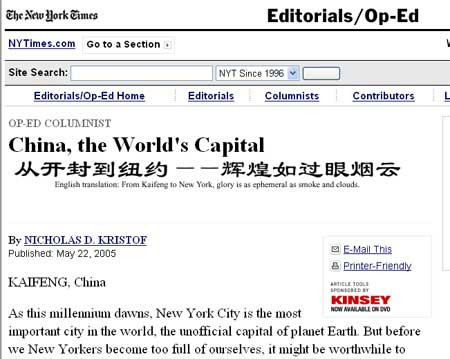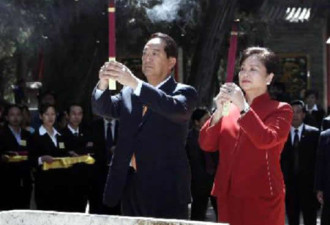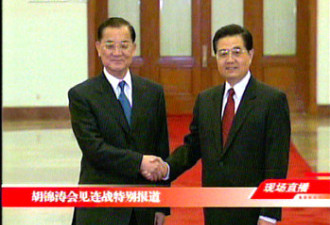纽约时报以中文标题发评论提醒美国
51编辑注:感谢网友浮云游月的推荐,原文在本网时事新闻论坛。另,此文作者的中文名字应当叫纪思道,在10几年前,他与他的中国妻子曾是美国驻中国的记者,因报道“六四”而获得过普利策奖。94年他们夫妻俩出过一部介绍中国的著作《中国觉醒了》,对中国当时的现状持严厉的批评态度。但近年来对中国的态度明显发生了变化,目前经常在纽约时报发表有关中国的评论,去年初发表的一篇“中国正悄悄赶上美国”曾引起了舆论很大的关注。

~~~~~~~~~~~~~~~~~~~~
《纽约时报》前天的评论版罕见地以中文标题发表著名专栏作家克里斯托夫(Nicholas D. Kristof)的评论文章:“从开封到纽约--辉煌如过眼烟云(Glory is as ephemeral as smoke and clouds)”。
这篇从中国中部城市开封发出的评论,回顾1000年前全世界最繁荣城市开封衰败的历史,提醒美国人,中国正在复兴,美国切不可骄傲自大
克里斯托夫说,美国现在是世界唯一超级强国,纽约是全世界最重要城市,许多美国人认为理所当然。但在1000年前,世界最重要城市却是黄河边上的开封。
他说:“我们如果回顾历史,会发现一个国家的辉煌盛世如过眼烟云,转瞬即逝,城市的繁华光景尤其如此。
“公元前2000年世界最重要城市是伊拉克的乌尔(Ur),公元前1500年世界最重要的城市或许是埃及的底比斯(Thebes),公元前1000年,没有一个城市可在世界上称雄,虽然有人提到黎巴嫩的西顿(Sidon),公元前500年可能是波斯(Persia)的波斯波利斯(Persepolis),公元1年是罗马,公元500年可能是中国的长安,公元1000年是中国的开封,公元1500年是意大利的佛罗伦萨(Florence),公元2000年是纽约。公元2500年,以上这些城市可能都榜上无名。
文章指出,美国人应该从历史中记取两个教训。“第一,保持科技领先和健全的经济政策极为重要。”古代中国繁荣的原因之一,是采取促进经济和贸易的政策,在铁犁、印刷术、纸币等方面进行技术革新。
“第二,傲慢自大非常危险。古代中国曾认为无须向外国学习任何东西,这是衰败的开始。
克里斯托夫指出,美国目前经济管理松懈,无法解决农业津贴或长期预算赤字问题,美国科技虽处于强势,但目前中小学生的数学和科学属二流水准,美国人对外国缺乏兴趣,与毫不松懈、生气勃勃、意志坚定的中国人形成鲜明对照。
By NICHOLAS D. KRISTOF
Published: May 22, 2005
KAIFENG, China
As this millennium dawns, New York City is the most important city in the world, the unofficial capital of planet Earth. But before we New Yorkers become too full of ourselves, it might be worthwhile to glance at dilapidated Kaifeng in central China.
Forum: Nicholas D. Kristof's Columns
Kaifeng, an ancient city along the mud-clogged Yellow River, was by far the most important place in the world in 1000. And if you've never heard of it, that's a useful warning for Americans - as the Chinese headline above puts it, in a language of the future that many more Americans should start learning, "glory is as ephemeral as smoke and clouds."
As the world's only superpower, America may look today as if global domination is an entitlement. But if you look back at the sweep of history, it's striking how fleeting supremacy is, particularly for individual cities.
My vote for most important city in the world in the period leading up to 2000 B.C. would be Ur, Iraq. In 1500 B.C., perhaps Thebes, Egypt. There was no dominant player in 1000 B.C., though one could make a case for Sidon, Lebanon. In 500 B.C., it would be Persepolis, Persia; in the year 1, Rome; around A.D. 500, maybe Changan, China; in 1000, Kaifeng, China; in 1500, probably Florence, Italy; in 2000, New York City; and in 2500, probably none of the above.
Today Kaifeng is grimy and poor, not even the provincial capital and so minor it lacks even an airport. Its sad state only underscores how fortunes change. In the 11th century, when it was the capital of Song Dynasty China, its population was more than one million. In contrast, London's population then was about 15,000.
An ancient 17-foot painted scroll, now in the Palace Museum in Beijing, shows the bustle and prosperity of ancient Kaifeng. Hundreds of pedestrians jostle each other on the streets, camels carry merchandise in from the Silk Road, and teahouses and restaurants do a thriving business.
Kaifeng's stature attracted people from all over the world, including hundreds of Jews. Even today, there are some people in Kaifeng who look like other Chinese but who consider themselves Jewish and do not eat pork.
As I roamed the Kaifeng area, asking local people why such an international center had sunk so low, I encountered plenty of envy of New York. One man said he was arranging to be smuggled into the U.S. illegally, by paying a gang $25,000, but many local people insisted that China is on course to bounce back and recover its historic role as world leader.
"China is booming now," said Wang Ruina, a young peasant woman on the outskirts of town. "Give us a few decades and we'll catch up with the U.S., even pass it."
She's right. The U.S. has had the biggest economy in the world for more than a century, but most projections show that China will surpass us in about 15 years, as measured by purchasing power parity.
So what can New York learn from a city like Kaifeng?
One lesson is the importance of sustaining a technological edge and sound economic policies. Ancient China flourished partly because of pro-growth, pro-trade policies and technological innovations like curved iron plows, printing and paper money. But then China came to scorn trade and commerce, and per capita income stagnated for 600 years.
A second lesson is the danger of hubris, for China concluded it had nothing to learn from the rest of the world - and that was the beginning of the end.
I worry about the U.S. in both regards. Our economic management is so lax that we can't confront farm subsidies or long-term budget deficits. Our technology is strong, but American public schools are second-rate in math and science. And Americans' lack of interest in the world contrasts with the restlessness, drive and determination that are again pushing China to the forefront.
Beside the Yellow River I met a 70-year-old peasant named Hao Wang, who had never gone to a day of school. He couldn't even write his name - and yet his progeny were different.
"Two of my grandsons are now in university," he boasted, and then he started talking about the computer in his home.
Thinking of Kaifeng should stimulate us to struggle to improve our high-tech edge, educational strengths and pro-growth policies. For if we rest on our laurels, even a city as great as New York may end up as Kaifeng-on-the-Hudson.
题图:纽约时报评论文章《从开封到纽约--辉煌如过眼烟云》


![[集市好物]2015 BMW X5](https://storage.51yun.ca/auto-car-photos/2222919e-512c-43fc-b667-c1e3b448df7f.800x600.jpg)


网友评论